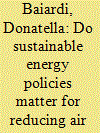|
|
|
Sort Order |
|
|
|
Items / Page
|
|
|
|
|
|
|
| Srl | Item |
| 1 |
ID:
125663


|
|
|
|
|
| Publication |
2013.
|
| Summary/Abstract |
Govt. of India has come up with renewable energy (RE) promotional policies and regulations to tap the abundant renewable energy sources in the country for energy security and to reduce the dependance on fossil fuels. Subsequent to the enactment of the Electricity Act 2003, Renewable purchase obligation (RPO) became mandatory on power distribution companies. Renewable energy certificate (REC) was introduced to help the obligated entities to meet their RPO irrespective of the availability of local RE sources and its trading started in India in March 2011. This paper briefs about the RE promotional policies and regulations of Govt. of India and analyses the RPO announced by various state electricity regulatory commissions (SERCs). A detailed analysis of REC trading at the energy exchanges till February 2013 is presented to show the REC market trend and the share of REC in the total RE requirement of the country. The impact of RE promotional policies and regulations on the RE sector is also analysed. Based on the above analysis, realistic policy modifications are suggested to improve the current status of the RE sector of India.
|
|
|
|
|
|
|
|
|
|
|
|
|
|
|
|
| 2 |
ID:
132646


|
|
|
|
|
| Publication |
2014.
|
| Summary/Abstract |
This article offers the first national examination of the determinants of adoption of wind and solar energy generation on U.S. farming operations. The inclusion of state policies and characteristics in a multilevel modeling approach distinguishes this study from past research utilizing logit models of technology adoption which focus only on the characteristics of the farm operation. Results suggest the propensity to adopt is higher for livestock operations, larger farms, operators with internet access, organic operations, and newer farmers. The results find state characteristics such as solar resources, per capita income levels, and predominantly democratic voting increasing the odds of farm adoption. This research suggests the relevance of state policy variables in explaining farm level outcomes is limited, although in combination best practice net metering and interconnection policies-policies designed to encourage the development of small scale distributed applications-are shown to increase the likelihood of farm solar and wind adoption. The prevalence of electric cooperatives-which are often not subject to state renewable energy policies and often service farms-is negatively related with the propensity to adopt and suggests that policy design may be a factor
|
|
|
|
|
|
|
|
|
|
|
|
|
|
|
|
| 3 |
ID:
176767


|
|
|
|
|
| Summary/Abstract |
Yes, they matter. To reply to this question, we assess the impact of energy efficiency and renewable energy policies on six different air pollutants: carbon dioxide (CO), methane (CH), nitrous oxides (NO), non-methane volatile organic compounds (NMVOCs), nitrogen oxides (NO) and sulfur dioxide (SO) in Italian provinces in the decade 2005–2015. The empirical analysis is performed in a panel data context by means of propensity score matching with multiple treatments, since our framework is characterized by the presence of two treatments, corresponding to the two different energy policies analyzed, i.e. energy efficiency policy and renewable policy. These two policies can be applied by each province as mutually exclusive strategies or as joint strategies. Our results show that renewable policies are the most effective in terms of climate goals especially when implemented on a local scale, while energy efficiency policies alone are ineffective. Moreover, the success of these policies depends on the type of pollutant to be reduced. Finally, we note that the effect of energy policies was reinforced by the counter-cyclical fiscal policies implemented to counter the Global Financial Crisis in 2008.
|
|
|
|
|
|
|
|
|
|
|
|
|
|
|
|
| 4 |
ID:
107508


|
|
|
|
|
| Publication |
2011.
|
| Summary/Abstract |
The purpose of this paper is to investigate price support for market penetration of renewable energy in developing nations through a decentralized supply process. We integrate the new decentralized energy support: renewable premium tariff, to analyze impacts of tariff incentives on the diffusion of renewable technology in Senegal. Based on photovoltaic and wind technologies and an assessment of renewable energy resources in Senegal, an optimization technique is combined with a cash flow analysis to investigate investment decisions in renewable energy sector. Our findings indicate that this support mechanism could strengthen the sustainable deployment of renewable energy in remote areas of Senegal. Although different payoffs emerged, profits associated with a renewable premium tariff are the highest among the set of existing payoffs. Moreover in analyzing impacts of price incentives on social welfare, we show that price tariffing schemes must be strategically scrutinized in order to minimize welfare loss associated with price incentives. Finally we argue that a sustainable promotion of incentive mechanisms supporting deployment of renewable technology in developing nations should be carried out under reliable institutional structures. The additional advantage of the proposed methodology is its ability to integrate different stakeholders (producers, investors and consumers) in the planning process.
|
|
|
|
|
|
|
|
|
|
|
|
|
|
|
|
| 5 |
ID:
105776


|
|
|
|
|
| Publication |
2011.
|
| Summary/Abstract |
The SET-Plan established a strategy to use Research and Innovation (R&I) to green the EU energy sector while ensuring a secure supply and increasing EU competitiveness. The strategy sets clear objectives and programming plans and takes stock of existing initiatives in the energy sector, fosters a cooperative approach to R&I, introduces a high-level steering group (the SET-Plan Steering Group) to monitor progress, creates a dedicated information system (the SETIS) to fill the void in policy information and produces estimates of financial needs over the programming period. In this respect, the SET-Plan could serve as a blueprint for R&I strategies to tackle other societal challenges. To be effective, such strategies should further clarify the hierarchy of existing objectives and instruments, introduce specific instruments to pull the demand of new technologies, strengthen links with education and training policies and formalize links with the governance structures of existing initiatives.
|
|
|
|
|
|
|
|
|
|
|
|
|
|
|
|
| 6 |
ID:
192784


|
|
|
|
|
| Summary/Abstract |
Renewable energy (RE) support policies play a significant role in promoting RE development. Both the feed-in-tariff (FIT) and renewable portfolio standards (RPS) policies have been implemented in China's power industry, but the market response is far from satisfactory. Additionally, a rush to promote electric power generation from RE sources poses operational hazards to the power system due to its intermittent nature. Therefore, this paper focuses on various forms of mainstream RE policies and develops system dynamics (SD)-based simulation models to examine their different incentive effects and evaluate the impacts on constructing a new power system for China. The simulation results show that the demand-side RPS (DRPS) outperforms the supply-side RPS (SRPS) policy at minimizing the costs of market participants, promoting RE consumption, constraining the damage for thermal power generation, and providing long-term incentives for RE industry investment, but lacks incentives for promoting the liquidity of Tradable green certificates (TGC) market. The combined FIT&RPS policy provides a transitional instrument to neutralize large volatility. When promoting energy transition, different RE policy forms should be enacted in stages and it is necessary to consider the construction of power grid systems and appropriately plan RE development to achieve balanced development.
|
|
|
|
|
|
|
|
|
|
|
|
|
|
|
|
|
|
|
|
|